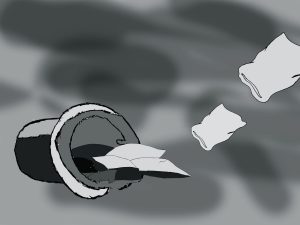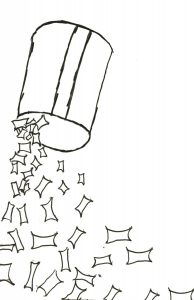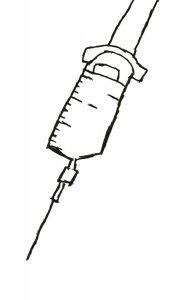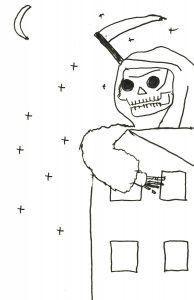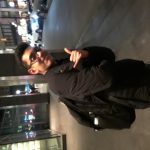Author: Joshua Steele
Final Project 3 Value + Color
Project 3 Check-In
7 ads
Project 3 Pencils
Reflection: Ad Agencies vs Graphic Design Studios
Joshua Steele
Topics in Graphic Design
4/10/2019
Reflection: Ad Agency vs Graphic Design
What we learned last week about ad agencies and design studios was interesting, it was something that I hadn’t considered when thinking about the different ways one can pursue a career in design.
One of the things that I found especially interesting was the more relaxed atmosphere of the graphic design studios, they took on a lot of work and the smaller ones especially seemed to have a more casual atmosphere. Despite this, they still had notable clientele, such as Hot Wheels for one, and it was still important work such as coming up with logos or helmet designs. At larger studios like Pentagram, they might be asked to do an entire rebrand.
In contrast the advertising studios had to work a lot faster and be a lot more technical. There are proposals flying back and forth, and some work is done unpaid, everything is ramped up including the pay, in a graphic design studio the pay is much more predictable and the work more varied, but in an ad agency you are much more likely to have a set role, pay might be more unpredictable, and also unlike a graphic design studio we learned you’re much more apt to be fired in an ad agency.
Overall it seems to me that for beginners, a design studio rather then an ad agency, might be the way to go, but for those who are confident in their skills and a much larger paycheck they might not mind the disadvantages an agency offers.
Midterm Event and Reflection
For my marketing event I went to People of Color in Publishing Presents: Diversity in Design Workshop + Portfolio Review, I met a ton of people there, several people that either work for Penguin Random House or for People of Color in Publishing, and got the contacts of eight people overall, five of which were students from Mercy College also attending the event, with the other three being professionals in the field.
I learned a lot from this event, one of which was the very focused portfolio that many people in the industry look for. They want to see nuance, skill, attention to detail, and for that, you could show them five different cover designs with interiors and they’ll be happy, maybe one or two extra things just to show range as another put it. I also learned that there is still a need for employment in the industry, one of the paneli
sts was a woman who had recently graduated Mercy College, and was a Junior Designer at Dutton, a subsidiary of Penguin Random House.
The panelists were very interesting, there were four of them three woman one man. Albert Tang is an art director, Marcie Lawrence is a senior graphic designer at Little Brown, Dominique Jones is a Junior Designer at Penguin, and Maya Battle works at Penguin but with a job she herself admitted is confusing and hard to explain, sin
ce she does a lot of different things, analytics, media buying, and so on.
Battle had many interesting things to say, she admitted that while her job was hard to explain she ended up with a lot of influence and could see a lot of how the company worked in general with its marketing, she lamented the push on advertising towards demographics, such as males 18-24, and herself would rather and tries to market to interest groups, such as coffee drinkers. She said specifically that the former assumes an entire group acts the same, while the latter allows for more targeted ads. This related to their universal opinion on book design, that it should be targeted and nuanced, when making a book for Alice in Wonderland for instance it might be easy to put a large cheshire cat on the cover, but a good designer will look into the interest groups and demographics to know how they relate to and enjoy the book so that the book cover can end up speaking directly to them, as if it was made for them.
This is something Battle attested to, she had found t
hat although she didn’t expect it her degree in Psychology greatly benefitted her because it enabled her to more easily understand people, and by doing this, she was able to create more successful projects. It is an often overlooked fact that with the myriad of projects a designer may get, each one must be detailed and precise, there is no time for creating easy or simple covers since the guy above you might hate all of the concepts.
At the bottom though it seemed a lot more relaxed, Jones was a junior
designer and didn’t have any of those more intense speeches, they gave her projects to do handbags with repeating patterns of cat heads, a few book covers here and there. Whether or not it was more intense I don’t know but she largely played it off.
After their panels and discussions there was a second part which had to do with resumes, I didn’t learn much but they mentioned to show range as far as skills go, and if you don’t have work to show, show work that explains your skills with each program.
After that there was the portfolio review, I got to
a man named Christopher Lin, an art director at Penguin, and we got to talking. Oddly, we didn’t discuss much about my resume, he wanted to know how I felt about the event and Penguin Random House more, and he recommended I read Game of Thrones which I later realized was published under a subsidiary of Penguin Random House. I felt a little flustered because the whole thing seemed really important, but I ended up getting his contact information, as well as a few others.
Another person that I met was an Author/Illustrator named Booki Vivat, she’s published three children’s books so far with the most recent having been published February, she was really bubbly and fun. She actually illustrated her own books so it was nice when I dug around and found her website, that the sketchbook illustrations she wa
s showing off, were near identical to the book cover illustrations.
It may sound extreme, but I think the event has solidified my goal of working in publishing and make Penguin Random House a goal as far as employers go, the atmosphere was relaxed but professional, and I never felt like I had to put on a mask so to speak, it matched myself in terms of tone. I choose the event because I knew it was what I wanted to do, but I didn’t feel the level of commitment that I do now, I’ll use the information to possibly keep in touch with the people I met, or at least keep track of them and the organization that organized it, as well as mess with my portfolio so it’s more focused to book design specifically. Shown below, are some of the Queens College students I took photos of after the event.
Movie Reflection
The Greatest Movie Ever Sold is a documentary that revolves around the advertising realm that invisibly pupeteers the world, placing ads on a building, making your favorite hero drive a specific car, so on, it went into some philosophical questions and showed its dangers as well as its strengths, but overall seemed to be about informing the viewer on its impact. The message of the movie by the end of it seemed to be something like, be aware of ads, or “do you want this?”
One area that the movie covered was a Brand’s personality. A brand’s personality is the way that it attempts to come off to the consumer, Nike’s might be ambitious for its emphasis on never giving up and following one’s passion for instance. My brand identity might be seen as Creative yet organized, since I enjoy coming up with different ways to present and do things, but within certain parameters. Brands that have the same personality might be Starbucks, Microsoft, Facebook, Penguin Random House, HarperCollins. and so on.
They used a lot of terminology that doesn’t normally come up either, for example Brand Collateral, which is how a brand is promoted, Co-Promotion, where two brands work together to advertise each other, Sell-Out, which isn’t really an industry term but seems to mean damaging one’s own Brand Identity by becoming more commercial for the sake of popularity, as opposed to Buying-In, which does the same thing without damaging one’s Brand Identity.
Shameless Self-Promotion is when you advertise yourself in a way that seems to betray your brand, it relates to selling-out in that way. Shameless Self-Promotion as opposed to selling-out though, can be done in a way that doesn’t actually hurt the brand, for the movie for instance, it actually worked out, since that was the entire point.
One of the things I learned from this movie was the importance of knowing who you want to market yourself to, and what you want to convey to others, it’s the kind of thing that was very important to the brands in the film. Another thing I learned was how important persistence and safety was, in the begining when he was still seen as dangerous or a wild card he got no calls back, but, through persistence he made some break-throughs and as brands saw him as a safe bet, things blew up. The most useful to me though, was the prevalence of ads that I got to learn through his movie, when researchers began to appear talking about how they influence us to buy things.
Essay 1: First Day
On the first day of class I remember going through the video with Chip Kidd and learning about the value of doodling, both were very interesting for me. Back in elementary school we used to constantly doodle, we would draw animals or people, and to stop that we had to keep that kind of thing to the arts and crafts class, so that all we did in our other class was simply answer questions and write. Certainly learned a lot, but it gets me thinking, how would I have learned if there was a non-ruled notebook in which I could draw whatever I want?
It’s the kind of free-thinking note-taking that Chip Kidd seems to do with his cover designs, he walked around his apartment block and found the interior designs inspiring for his books, thinking on the fly and then fleshing them out to become something useful. You wouldn’t expect such a high-profile designer to take inspiration from such lowly things, a horizon maybe, or a famous painting, but the elevator?
I remember this was what struck me in that first class and what remained true in each class. Designers are people like me, they doodle, they have artist’s block, they have people that shoot down what they think are great ideas. It doesn’t matter whether they get paid six or two or one figure they never stop being human, and I found that a little inspiring, learning the humanity of these designers that can seem otherworldly with their insane portfolios.
Asking her questions about the field was enlightening, I’d already decided I wanted to work in print but I always think in the back of my mind that I’ll have a professor look at me, give me a funny look, and tell me I’m insane for working in a dying or dead industry, that I’ll never make money by it. It was nice to hear her weigh both sides, the industry wasn’t as strong as before, it was changing, but progress could be made and no field ever really dies. This is one of the reasons that I grew to really enjoy this class, it’s directly useful, not a foray into various projects that I’ll never look back on, it gets to my field and my career, which if I’m smart, will stick with me.
Reflection: Brands and Me
Joshua Steele,
Topics in Graphic Design,
3/13/2019
Essay 4: What is my Brand?
I remember when I used to learn branding at my high school, the High School for Innovation in Advertising and Media, I would learn how each brand had a specific feel and mood to it, Nike was ambitious, Starbucks was reliable, Mcdonalds was that and family friendly, you could go through each brand and if done well, associate it with various feelings, colors, and so on. This surprising can also happen to people, we all have a view of Steve Jobs that reads creativity and precision, one of Elon Musk that says innovation and forward thinking, this is especially important in politics where candidates have to know how to brand themselves, Clinton as caring, strong, progressive, Trump as blunt and honest, having a consistent and noticeable Brand Identity aids in Brand Recognition and the effectiveness of ads and everything else.
Learning in the class the importance of coming off to people in a certain way, and getting to know what places one wants to work, I started to think. If I had to pick what my brand was, how I came off or at least tried to come off to most people, I would say Creative but Organized, I like to think about different ways to present something, how to make something look nice, vibrant, and I like to be spontaneous at times, yet I also like to keep a timetable, and to be predictable for the most part. I like to know what I’m doing, when it’s due, and so on, and then to use my creative side within that framework.
Looking at myself like that, brands like Penguin Random House, and Microsoft, resonate with me, both know what they’re doing and at the expense of some success stay focused on what they do, growing and being creative but always staying within a wider niche. Microsoft only just began making hardware even though they’re often pitted as competitors with Apple, a hardware giant, showing that even in the face of tension they don’t change what they do lightly. Penguin Random House publishes 70,000 ebooks and 15,000 print books every year and was named top mid-size publisher of 2018 for their great hiring and success, that’s the kind of success I want.
I resonate with these brands because they have the same focus as me, without losing a creative edge, they do the same general work without being monotonous, that’s the kind of career I want as I move out into the field.

